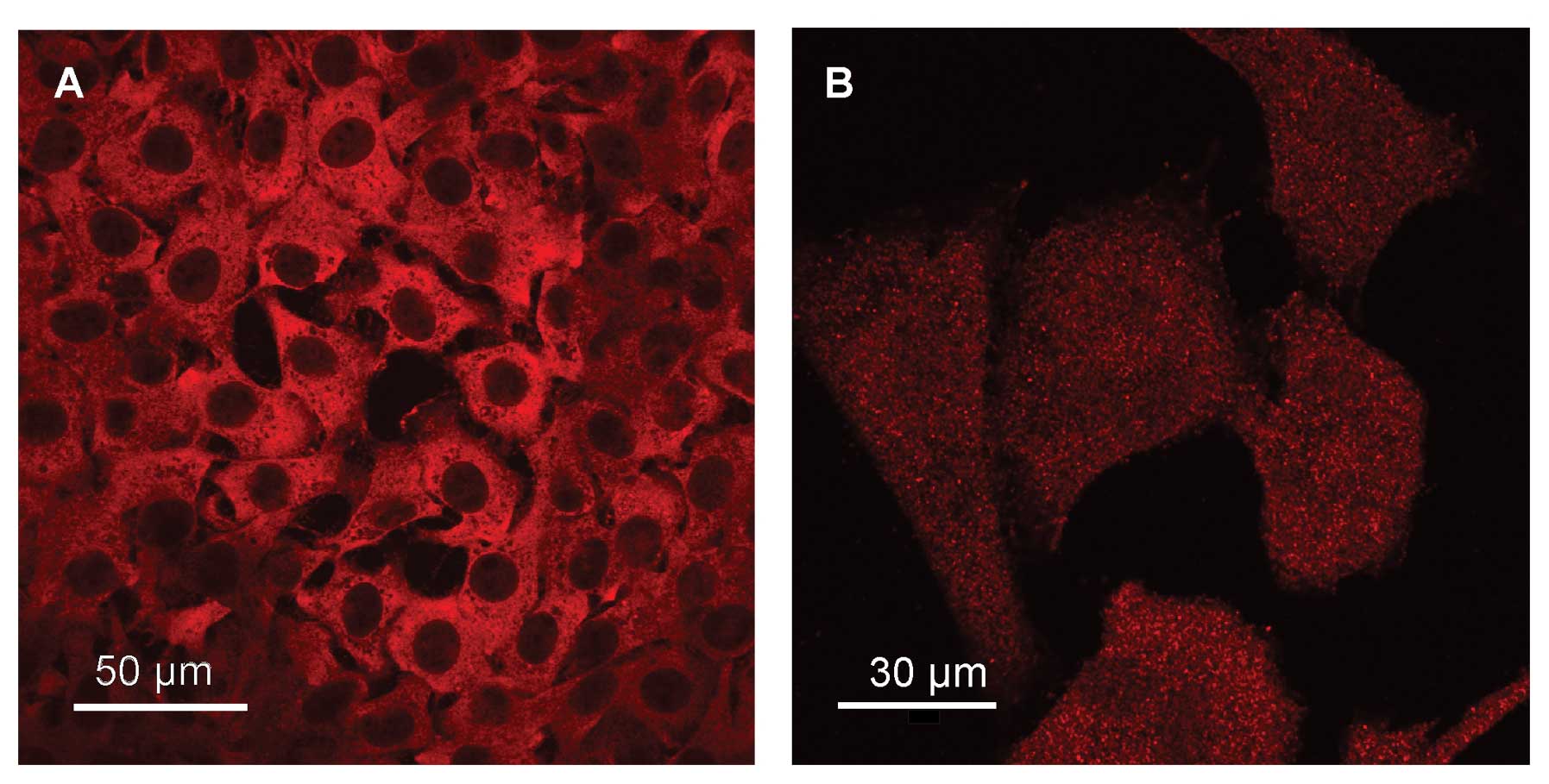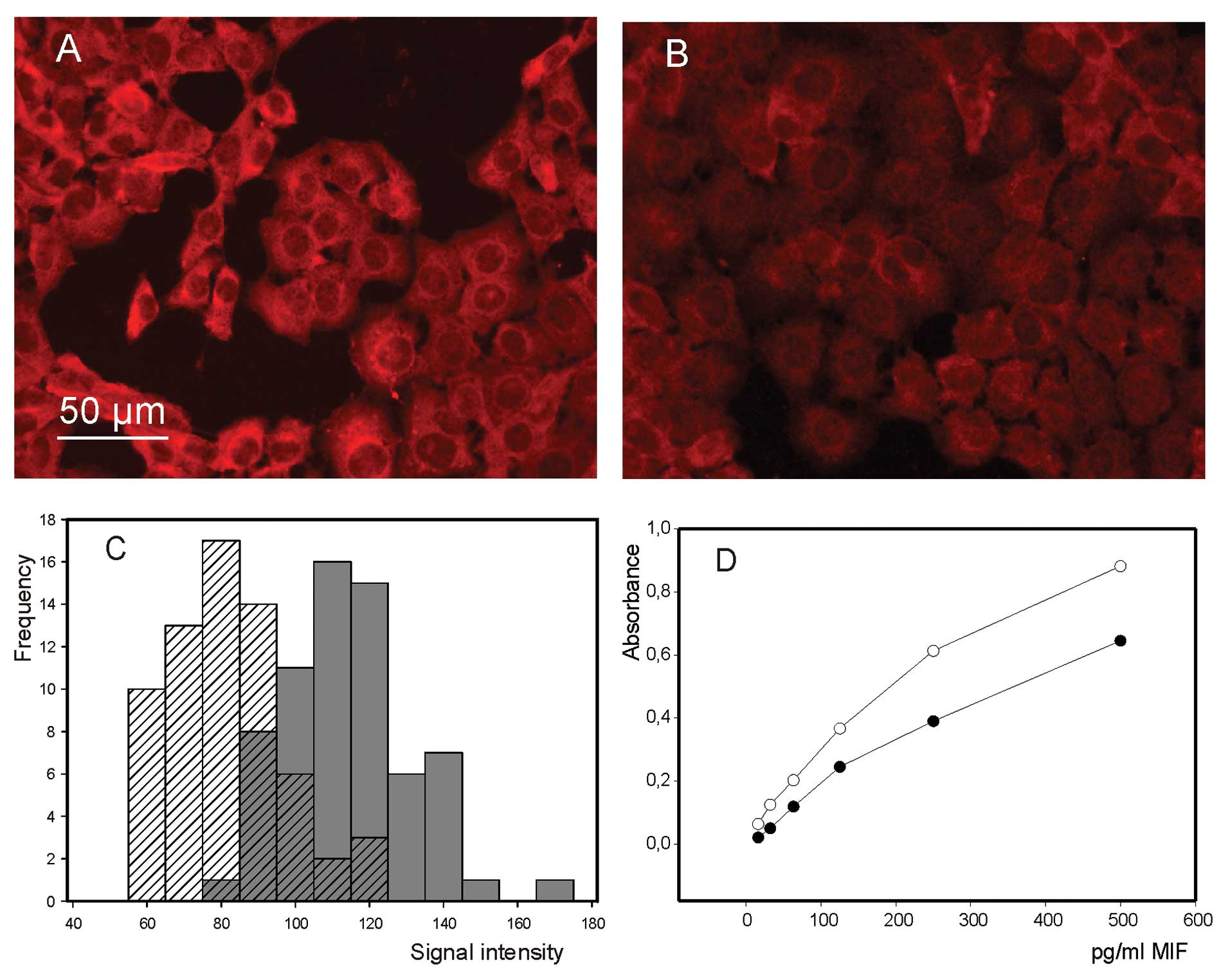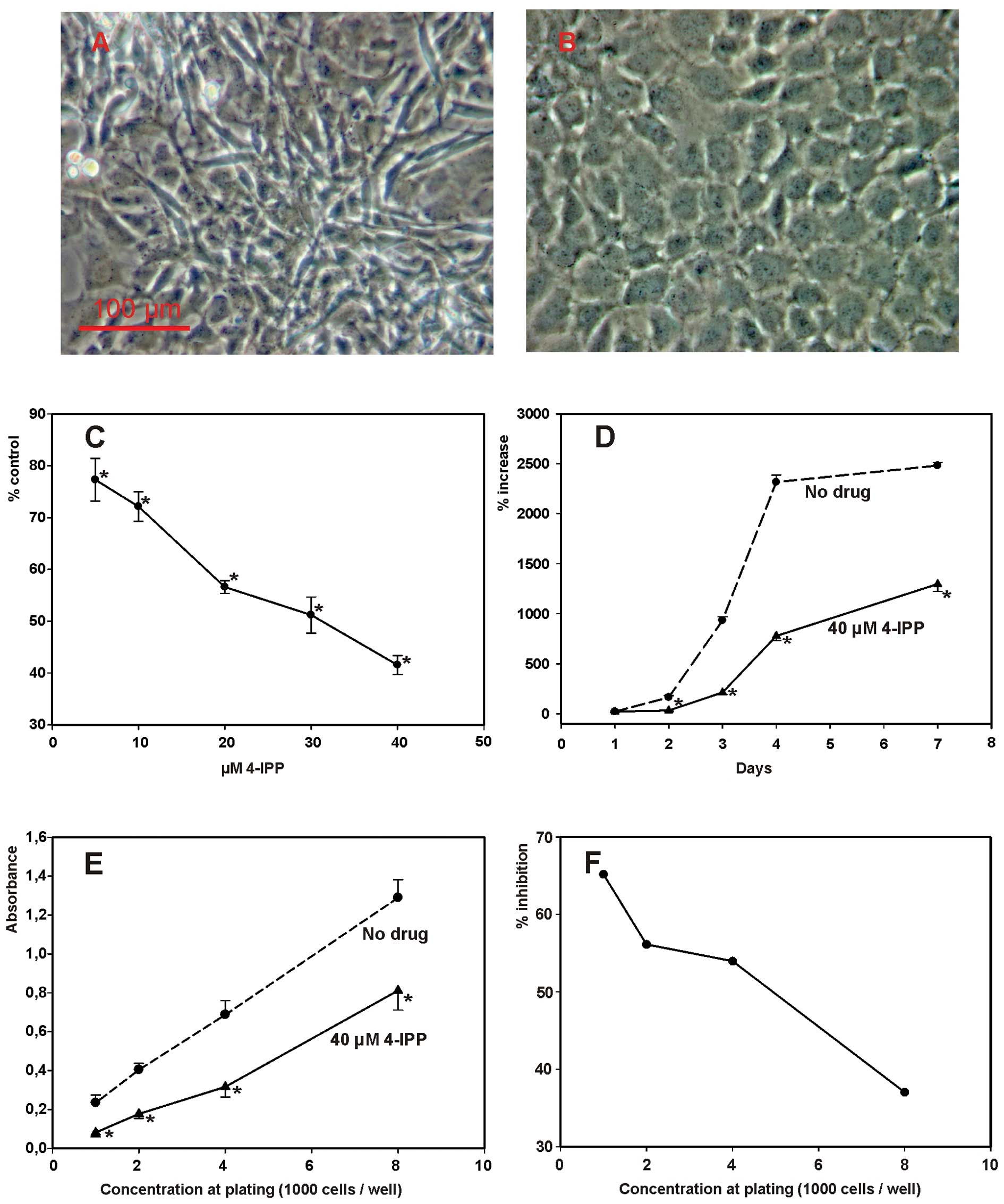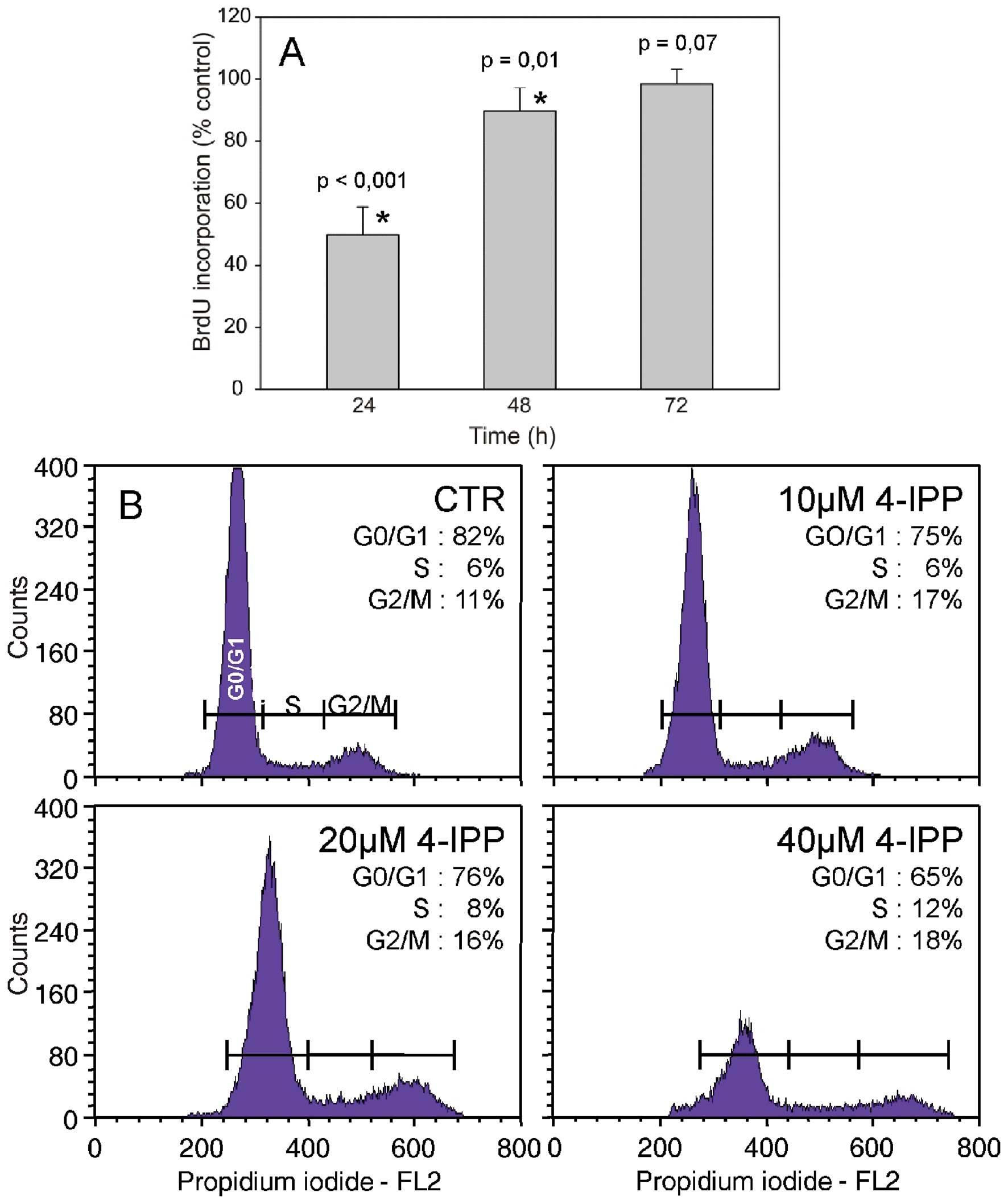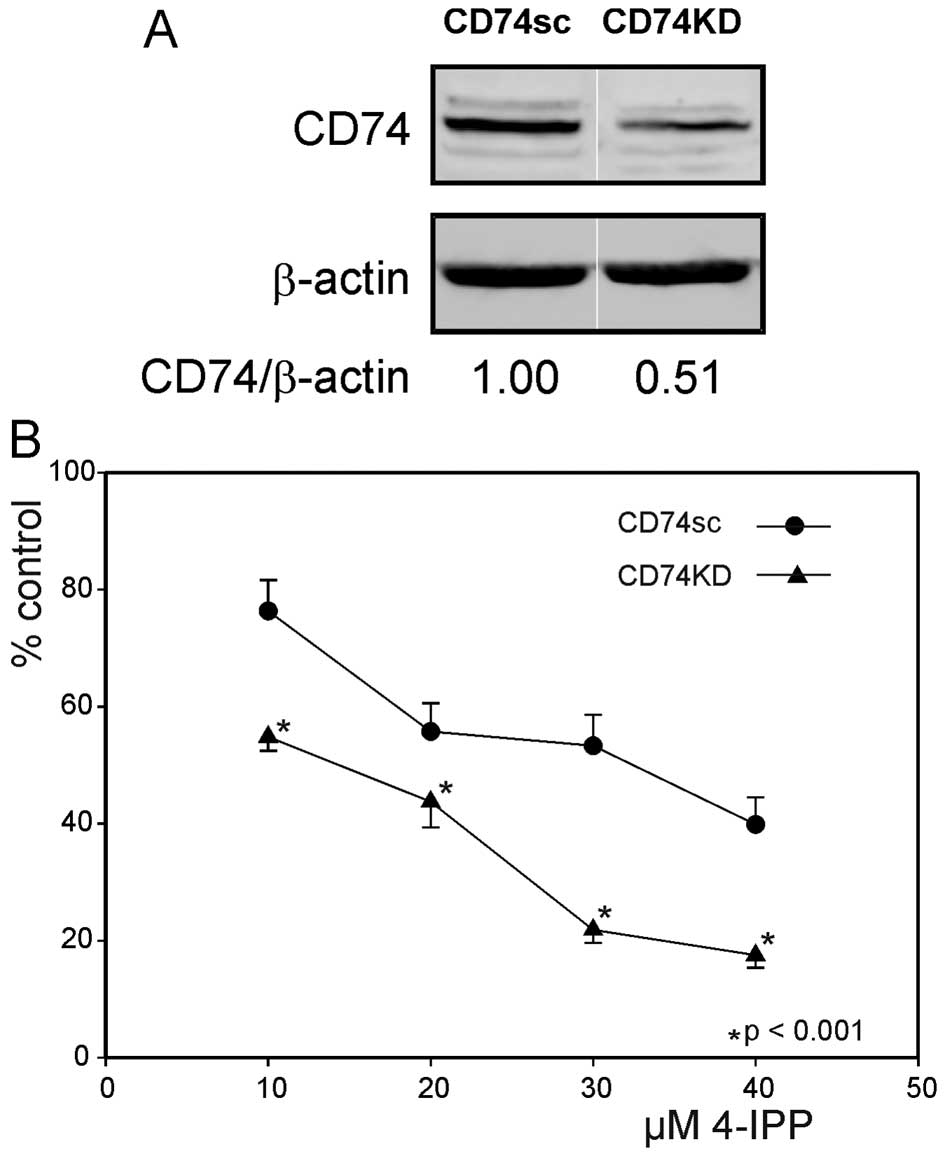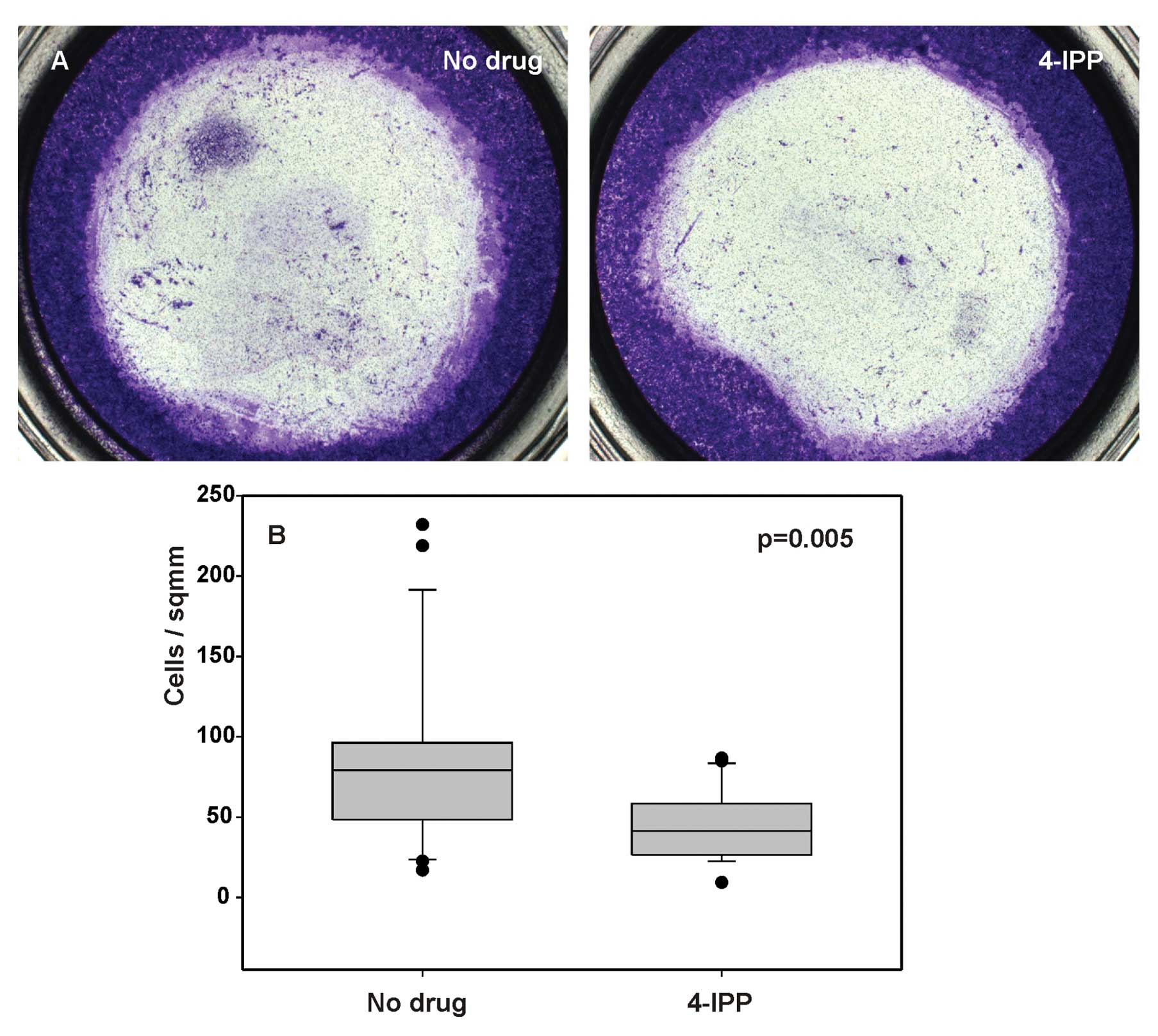Pharmacological inhibition of macrophage migration inhibitory factor interferes with the proliferation and invasiveness of squamous carcinoma cells
- Authors:
- Published online on: May 16, 2013 https://doi.org/10.3892/ijo.2013.1944
- Pages: 185-193
Abstract
Introduction
Macrophage migration inhibitory factor (MIF), originally named based on its repressive action on the motility of monocytes/macrophages, belongs to the cytokine family of signaling molecules. Although its existence as an extracellular regulator had been postulated since the late 1950s, it was not until 1989 that MIF was formally identified thanks to cDNA cloning and sequencing (1). A few years later the three dimensional structure of MIF was elucidated by structural analysis of the pure recombinant protein (2–4).
MIF is primarily known as a pro-inflammatory cytokine released by several cell types of the immune system, in particular macrophages and T cells, although its production is by no way restricted to immune cells. In addition to its paracrine activity, it can also act in endocrine fashion when secreted by corticotrophic cells of the pituitary (5). Physiologically, MIF has been shown to counteract the anti-inflammatory activivity of glucocorticoids at various levels, thus keeping a balance between pro-inflammatory and anti-inflammatory mechanisms (6). Expectedly, a dysregulation/exacerbation of MIF activity has been implicated in pathological conditions as diverse as asthma (7), chronic colitis (8), rheumatoid arthritis (9), systemic lupus erythematosus (10), psoriasis (11) and non-insulin-dependent diabetes mellitus (12).
As also seen for other cytokines such as interleukin-6, evidence is growing that MIF, beside its role in immune responses, could also be involved in neoplastic transformation and tumor progression. Among the earliest experimental observations that MIF might contribute to tumor development was the negative impact of MIF immunoneutralization on neoplastic growth in a mouse model of B cell lymphoma (13).
In the context of human cancer, MIF increase associated with neoplastic diseases was first suggested by ligand histochemistry using sarcolectin (14–16), soon followed by histochemical demonstration of MIF overexpression in prostatic adenocarcinoma metastases (17). More recent studies have reported MIF overexpression in a variety of human cancers, such as gastric adenocarcinoma (18), ovarian cancer (19), colorectal carcinoma (20) and cervical cancer (21). In the case of head and neck squamous cell carcinomas (HNSCC), studies by our group have disclosed an enhanced MIF expression in oral cavity, laryngeal and hypopharyngeal squamous cell tumors (22–24). Of particular interest, stable MIF knockdown in a murine ovarian cancer cell line has been shown to decrease tumor burden and confer longer survival in tumor transplanted mice (19). A similar result was obtained after administration of anti-MIF therapeutics, either MIF-neutralizing antibodies or the MIF inhibitor ISO-1, to mice grafted with colorectal carcinoma transplants (20).
MIF exhibits a non-physiologic dopachrome tautomerase activity which has been extensively exploited to screen for potential inhibitors, owing to the fact that compounds antagonizing this enzymatic activity are also likely to disrupt MIF interactions with cognate receptors such as CD74 and suppress thereby its effects on target cells (25). Along this line, a new potent inhibitor of MIF dopachrome tautomerase activity, 4-iodo-6-phenylpyrimidine (4-IPP) has been shown to decrease the motility and anchorage-independent growth of lung adenocarcinoma cells (26).
Since MIF has been reported to be overexpressed in head and neck squamous cell carcinomas (22–24), the present study was undertaken to examine possible inhibitory effects of 4-IPP on SCCVII squamous carcinoma cells.
Materials and methods
Inhibitor and antibodies
MIF inhibitor 4-iodo-6-phenylpyrimidine (4-IPP) was purchased from Tocris Bioscience (Bristol, UK). Stock solutions of the compound, prepared ≥250-fold concentrated in ethanol, were stored at −20°C and used within the month. Polyclonal antibody against purified MIF (14) was raised in rabbits. Serum IgG fraction was purified as described previously (24). Rabbit polyclonal anti-CD74 antibody (FL-296), raised against residues 17-296 of human CD74, was obtained from Santa Cruz Biotechnology (Santa Cruz, CA). Cell culture medium and supplements were from Lonza (Verviers, Belgium). Fetal bovine serum (FBS) was from Hyclone (Logan, UT). Other chemicals were from standard commercial sources.
Cell line and culture
The squamous cell carcinoma cell line SCCVII (27) was a kind gift from Dr Shulin Li (Louisiana State University). Routine cell propagation and experimental studies were carried out at 37°C in a cell incubator with humid atmosphere at 5% CO2. Unless specified otherwise, cells were cultured in T-flasks containing Dulbecco’s modified essential medium (DMEM) supplemented with phenol red, 10% FBS, 25 mM N-2-hydroxyethylpiperazine-N’-2-ethanesulfonic acid (HEPES), 2 mM L-glutamine and 1X antibiotic/antimycotic mix.
A CD74 knockdown (CD74-KD) cell line derived from SCCVII, as well as a matched control with normal CD74 expression, were generated in our laboratory. Knockdown of CD74 expression was achieved by using anti-CD74 shRNA (mouse) lentiviral particles from Santa Cruz. Controls were obtained by transduction with shRNA lentiviral particles encoding a scrambled (sc) shRNA sequence (CD74sc). Transduced cells were selected by addition of 4 μg/ml puromycin to the culture medium. Preliminary experiments showed this puromycin concentration to be toxic toward non-transduced SCCVII cells.
Western blotting
Transduced SCCVII cells (CD74sc and CD74KD) were plated in Petri dishes (106 cells/dish), cultured for 3 days and then lysed using a detergent cocktail (M-PER Mammalian Extraction buffer) supplemented with protease (Halt Protease Inhibitor Cocktail) and phosphatase inhibitors (Halt Phosphatase Inhibitor Cocktail) (all from Pierce, Rockford, IL, USA). Protein concentrations were determined by the BCA Protein assay (Pierce) using bovine serum albumin as standard. Extracted proteins (30 μg) were subjected to 10% SDS-PAGE and electrotransferred onto nitrocellulose membranes (iBlot® Dry Blotting system, Life Technologies-Invitrogen, Gent, Belgium). Immunodetections were performed using anti-CD74 antibody FL-296 (1/200). Peroxidase-labeled anti-rabbit IgG antibody (1/5,000) (from Amersham Pharmacia Biotech, Roosendaal, The Netherlands) was used as secondary reagent. Bound peroxidase activity was revealed using the SuperSignal® West Pico Chemiluminescent Substrate (Pierce) following the manufacturer’s instructions. Immunostaining signals were digitalized with a PC-driven LAS-3000 CCD camera (Fujifilm, Tokyo, Japan), using a software specifically designed for image acquisition (Image Reader, Raytest®, Straubenhardt, Germany). Immunoreactive band intensities were quantified using the software AIDA® Image Analyser 3.45 (Raytest).
Measurement of cell culture growth by cell counting
SCCVII cells were plated at a density of 104 cells/cm2 in 12-well dishes. The next day, cell cultures were fed fresh medium with or without 4-IPP (concentrations specified in Results). Measurement of cell culture density was performed either daily (time-course experiment) or after 3 days of treatment. Cells were dislodged from the vessel bottom by treatment with trypsin-EDTA solution (Lonza). After vigorous pipetting, concentrations of cells in suspension were determined in an electronic cell counter (model Z1 Coulter counter, Beckman Coulter, Fullerton CA).
Measurement of cell culture growth by crystal violet stain assay
Cell density was also assessed by colorimetry after crystal violet staining, as described previously (28). Cells were seeded in 96-well plates (1,000–2,000 cells/well). The following day, they were fed fresh medium (DMEM, 10% FBS) with or without 4-IPP. After a 3-day exposure, the culture medium was discarded and cells were fixed with 1% glutaraldehyde. Following fixation, cells were stained with 1% crystal violet. Destaining was achieved under gently running tap water and cell monolayers were lysed in 0.2% Triton X-100. The absorbance of cell lysates was measured at 570 nm using a Labsystems Multiskan MS microplate reader.
Measurement of cell culture growth by bromodeoxyuridine incorporation
DNA synthesis in SCCVII cells was evaluated on the basis of bromodeoxyuridine (BrdU) incorporation measured using an enzyme immunoassay kit developed by Roche Diagnostics (Mannheim, Germany). The assay was performed following the manufacturer’s instructions, with minor modifications. Briefly, SCCVII cells were plated in 96-well plates (2,000 cells/well) and treated the following day with 4-IPP. For the assessment of BrdU incorporation into DNA, the cell cultures were exposed for 50 min to BrdU labelling solution, followed by fixation and denaturation with an ethanol-based mixture. Thereafter cells were incubated for 30 min in a blocking solution (Animal-Free Blocker, Vector Laboratories, Burlingame, CA). The next step consisted in incubating cells in the presence of an anti-BrdU antibody conjugated with horseradish peroxidase. Immunocomplexes were detected by using a mixture of H2O2/tetramethylbenzidine as substrate. After addition of the stop solution (1 M H2SO4), the absorbance of the samples was measured at 450 nm (reference wavelength, 690 nm) in a microplate reader.
Cell cycle analysis by flow cytometry
The effect of 4-IPP on SCCVII cell cycle was examined using the Cell Cycle Phase Determination kit from Cayman Chemical Co. (Ann Arbor, MI). Cells were seeded in 6-well plates (10,000 cells/well) and cultured for 24 h prior to exposure to 10, 20 or 40 μM 4-IPP or vehicle for 48 h. After treatment, cells were collected (trypsin-EDTA solution), centrifuged (500 × g, 5 min) and washed twice with assay buffer (Cayman Chemical Co.) before incubation in fixative solution (Cayman Chemical Co.) for at least 2 h. Fixed cells were centrifuged, suspended in 0.5 ml staining solution (propidium iodide and RNase solution) (Cayman Chemical Co.) and incubated for 30 min at room temperature in the dark. Finally, the samples were analyzed in the FL2 channel of a flow cytometer (FACSCalibur, Becton-Dickinson, Franklin Lakes, NJ) equipped with a 488-nm excitation laser.
Evaluation of MIF immunoreactivity by enzyme-linked immunosorbent assay
The immunoreactivity of MIF protein was assessed by a sandwich enzyme-linked immunosorbent assay (ELISA) using a commercial kit (DuoSet ELISA Development kit, R&D Systems, Minneapolis, MN). Ninety-six well ELISA plates were coated overnight with 100 μl/well of capture antibody (mouse anti-human MIF). After 3 rinses of the wells with washing buffer (PBS, 0.05% Tween-20), non-specific binding was prevented by adding the reagent diluent containing 1% BSA and incubating for 1 h. The above mentioned rinsing procedure was applied between all subsequent steps. The blocking step was followed by the addition of increasing concentrations of human recombinant MIF in reagent diluent. After an incubation period of 2 h, 100 μl of detection antibody (biotinylated goat anti-human MIF) were added to each well. A 2-h exposure to the detection antibody was followed by a 20-min incubation with 100 μl of horseradish peroxidaseconjugated streptavidin. Immunocomplexes were revealed by the addition of 100 μl substrate solution (H2O2/tetramethylbenzidine). After stopping the reaction with H2SO4, the absorbance of the samples was measured at 450 nm (reference wavelength, 570 nm) as described above.
Immunofluorescence microscopy
SCCVII cells were plated at a density of 5,000 cells/cm2 on sterile round glass coverslips in 12-well dishes. The following day, they were fed fresh medium with or without 20 μM 4-IPP. After 3 days of drug exposure, cell monolayers were fixed with 4% paraformaldehyde in Dulbecco’s PBS (DPBS). Following fixation, paraformaldehyde was changed for DPBS where cell cultures were stored at 4°C until immunostaining. Before application of antibodies, cell monolayers were rinsed several times with PBS (0.04 M Na2HPO4, 0.01 M KH2PO4, 0.12 M NaCl, pH 7.2) containing 0.1% Triton X-100 (the same detergent-containing buffer was used for subsequent incubations and rinsing steps). Prior to exposure to primary antibodies, cells were preincubated for 20 min in PBS containing 0.05% casein and 0.05 M NH4Cl to prevent non-specific adsorption of immunoglobulins. Cells were exposed for 60 min to the primary antibody (either anti-MIF or anti-CD74) diluted 1:50 in PBS containing 0.05% casein. This was followed by a 30-min exposure to biotinylated goat anti-rabbit IgG (Vector Laboratories). Thereafter, the cell preparations were incubated for 30 min in the presence of Texas Red-conjugated streptavidin (Vector Laboratories). After final rinses in PBS, the coverslips were mounted on glass slides using commercial anti-fading medium (Vectashield®, Vector Laboratories). Negative controls were produced by omitting the incubation step with primary antibodies. This modification resulted in a decrease of the fluorescence signal to background level.
The cell preparations were examined on a Leitz Orthoplan microscope equipped with a Ploem system for epi-illumination. Excitation wavelength of 560 nm and emission wavelength of 590 nm were used for the observation of Texas Red fluorescence. Image capture was achieved using a PC-driven digital camera (Leica DC 300F, Leica Microsystems AG, Heerbrugg, Switzerland) operated with Leica IM50 software. Quantitative analysis of fluorescence signals was performed on digitalized images thanks to Image J™ (a public domain image software developed by W. Rasband at the Research Services Branch of the National Institute of Mental Health, NIH). Images were analyzed in the red channel after RGB split. Gray levels (on a scale of 0–225), corresponding to fluorescence intensity were determined in 65 cells in each control or treated cultures. Distribution histograms were plotted using Sigma Plot (Systat Software, Inc., Hounslow, UK). Confocal microscopy observations were carried out using an Olympus FV1000D laser scanning inverted microscope equipped with a red laser diode (LD559).
Phase contrast microscopy
Appearance of live cells in cultures was documented by phase-contrast microscopy using a Wilovert inverted microscope (Leitz, Wetzlar, Germany) equipped with a Leica DC 300F digital camera (see above).
Cell migration assay
Cell invasiveness was assessed by a Boyden chamber assay consisting of 24-well plates (lower chambers) with cell culture inserts (upper chambers), both chambers being separated by a polycarbonate membrane (8-μm size) coated with an artificial extracellular matrix (Chemicon Cell Invasion Assay kit, Millipore, Billerica, MA). The kit was used according to the manufacturer’s instructions. SCCVII cells were seeded in cell culture inserts (1.5×105 cells/insert) in serum-free medium (DMEM). The lower chambers were filled with complete medium (DMEM, 10% FBS) with or without 40 μM 4-IPP (n=4). After 96 h, cells were wiped off the upper surface of cell culture inserts with a cotton-tipped swab and the migrating cells were stained with crystal violet and counted in 6 microscopic fields (magnification ×10) using a Zeiss Axio scope A1 microscope (Carl Zeiss, Germany).
Statistical analyses
SigmaPlot® 11 software was used for statistical analyses. Parametric analysis was performed by ANOVA (>2 groups, pairwise comparisons achieved by the Holm-Sidak method) or Student’s t-test (2 groups). Non-parametric analysis used the Mann-Whitney rank sum test.
Results
SCCVII cells express both MIF and CD74
Demonstration of MIF in SCCVII cells by immunofluorescence microscopy is illustrated in Fig. 1A. MIF immunoreactivity is extranuclear and appears distributed throughout the cytoplasm of cells. Unlike that recently reported for MIF distribution in glioblastoma cells (29), the current data give no evidence of a prominent perinuclear localization. Similar to MIF, CD74 seems to be expressed by most, if not all SCCVII cells. Immunoreactive CD74 exhibits a punctuated pattern on the whole cell surface (Fig. 1B), a distribution consistent with the membrane localization of the receptor.
4-IPP alters MIF immunoreactivity
Fluorescence micro scopy examination of MIF in 4-IPP-treated cells revealed a decrease in the intensity of immunofluorescence signal (Fig. 2A and B), further confirmed by image analysis (Fig. 2C). Even though this observation is suggestive of a decrease in MIF expression, the inhibitory action of 4-IPP should not be expected to affect cell MIF content. Yet, it is well known that 4-IPP, like other irreversible MIF inhibitors, reacts covalently with the N-terminal proline of MIF (26), inducing thereby a conformational change of the protein that could modify its immunoreactivity. Thus, we checked MIF immunoreactivity by enzyme-linked immunoassay in presence and absence of 4-IPP. As revealed by data presented in Fig. 2D, the addition of 4-IPP resulted in a marked decrease of absorbance associated with the formation of immunocomplexes, clearly showing that 4-IPP drastically alters MIF immunoreactivity.
4-IPP inhibits the proliferation of SCCVII cells
Routine examination of SCCVII cell cultures exposed to 4-IPP (Fig. 3A and B) suggested that the MIF inhibitor might exert an inhibitory effect on cell proliferation. Thus, cell culture growth studies were conducted in order to disclose a possible effect of MIF inhibition on cell proliferation. As illustrated in Fig. 3C, 4-IPP provoked a dose-dependent decrease of cell culture growth with an IC50 ∼30 μM. At 40 μM 4-IPP, its inhibitory action on cell proliferation was already apparent after 1 day of exposure (Fig. 3D). Observations based on cell counting were confirmed by crystal violet stain assay (Fig. 3E). In the latter assay, the extent of the cytostatic effect produced by 4-IPP was inversely related to cell plating concentration (Fig. 3F). IPP-4-induced decline in cell proliferation prompted us to examine the effect of the MIF inhibitor on DNA synthesis and the cell division cycle. Cell treatment with 4-IPP resulted in a transient reduction of BrdU incorporation into DNA, which lasted 2 days after drug addition (Fig. 4A). As shown by flow cytometry analysis of the cell cycle, a 2-day exposure to 4-IPP led to a substantial cell accumulation in the G2/M phase of the cell cycle.
Expression of CD74 modulates SCCVII cell sensitivity to 4-IPP
MIF action on target cells notably depends on binding of its cognate receptor CD74 and the ensuing activation of downstream transduction cascade(s). Thus, we wondered whether a change of CD74 expression in SCCVII might influence their sensitivity to 4-IPP. The expression of CD74 was partially abrogated by lentiviral transduction of shRNA targeting the transcript (Fig. 5A). Fig. 5B illustrates the inhibition of growth induced by 4-IPP in CD74KD cells, as compared to control CD74sc cells. Blunting of CD74 expression clearly sensitizes cells to the cytostatic action of 4-IPP.
4-IPP reduces cell invasiveness
To evaluate whether MIF activity correlates with the invasiveness of SCCVII cells, we performed an in vitro cell invasion assay to determine the effect of 4-IPP on cell migration in Boyden chambers. 4-IPP at a concentration of 40 μM reduced the number of cells that migrated through the membrane as compared to untreated cells (Fig. 6A). The decrease of cell migration as a result of 4-IPP action was quantified by cell counting (Fig. 6B, p= 0.005). This result suggests that MIF promotes cell migration through extracellular matrix and could contribute to tumor invasiveness in vivo.
Discussion
The prominent role of MIF as a proinflammatory cytokine makes it an attractive therapeutic target for the management of autoinflammatory disorders. Thus, there has been an intensive search for pharmacological compounds capable of blocking MIF activity. The design of new molecules and the high throughput screening for potential MIF inhibitors have been facilitated by the fact that MIF possesses an enzymatic activity of D-dopachrome tautomerase. Albeit of unknown physiological significance, this tautomerase activity has been exploited as a validation tool for the identification of MIF inhibitors, since substances blocking this enzymatic activity would also be likely to interfere with MIF binding to its cognate receptor CD74. The first published report of a pharmacologically active MIF inhibitor described the properties of ISO-1 ((S,R)-3-(4-hydroxyphenyl)-4,5-dihydro-5-isoxazole acetic acid methyl ester). In vitro, ISO-1 was shown to abrogate MIF-mediated macrophage response to bacterial endotoxin, whereas in vivo it improved animal survival in a murine model of peritonitis-induced sepsis (30).
There is converging evidence that MIF contributes to tumor progression in various human cancers. In particular, recent observations of our group suggest an involvement of MIF in HNSCC. Indeed, immunohistochemistry reveals an increase of MIF immunostaining intensity during progression to neoplasia in hypopharyngeal (24), oral cavity (22) and laryngeal (23) squamous cell carcinomas. Higher serum levels were also found in patients with HNSCC, as compared to healthy individuals (23). These clinical observations were complemented by in vitro and in vivo studies on squamous cell carcinoma cell line SCCVII, where we showed that MIF knockdown decreases cell proliferation and motility and increases cell sensitivity to the anticancer drugs cisplatin and 5-fluorouracil (23).
Insofar as MIF seems to contribute to tumor progression, MIF inhibitors might be effective as anticancer drugs. Lending support to this assertion, ISO-1 has been reported to reduce the proliferation of glioblastoma multiforme cells in vitro (29) and inhibit the growth of tumor xenografts produced by the inoculation of prostate cancer cells (31) or colon carcinoma cells (20). In the present study, we investigated the impact of pharmacological MIF inhibition on the behaviour of SCCVII squamous carcinoma cells, since previous observations show that they are partially dependent on endogenous MIF for growth (23). As a test compound, we used 4-IPP (4-iodo-6-phenylpyrimidine), a suicide substrate which has been recently shown to exhibit 5–10 times more inhibitory potency than ISO-1 (26).
In the present study, preliminary experiments based on immunofluorescence staining revealed that SCCVII cells exhibit both MIF and CD74 immunoreactivities. Although similar studies have rarely been performed on tumor cells, MIF and CD74 have been previously shown to be co-expressed in non-small cell lung cancer (32). The intracellular pattern of MIF immunofluorescence in SCCVII cells was reminiscent of that reported for macrophages (33). As could be expected for a cell surface receptor, the distribution of immunoreactive CD74 markedly differed from that of MIF. Assuming that MIF can be secreted by SCCVII cells, the simultaneous expression of the cytokine and its receptor implies the possibility of auto-crine stimulation.
The finding that 4-IPP treatment resulted in a decrease of MIF immunofluorescence intensity in SCCVII cells was at first sightly surprising since MIF inhibition has not been reported to decrease the expression of the cytokine in treated cells. As a matter of fact, ISO-1 has been observed to enhance rather than reduce MIF expression in glioblastoma multiforme cells (29). Further investigations relying on ELISA showed that 4-IPP actually alters MIF immunoreactivity, a finding consistent with a covalent modification of the latter. Similar observations on 4-IPP-induced alteration of MIF immunoreactivity have been reported previously (33).
Assessment of cell proliferation in presence of 4-IPP showed that the drug exerts a dose-dependent cytostatic effect on SCCVII cells, without evidence of apoptotic cells in treated cultures. CD74 knock-down definitely resulted in an increase of SCCVII cell sensitivity to 4-IPP. The additive effect of CD74 knock-down and 4-IPP suggests that MIF promotes SCCVII cell proliferation by interacting with CD74/CD44 and triggering downstream signalling events. Although the identity of the signalling pathway was not specifically investigated in the present study, MIF-induced enhancement of cell proliferation is generally assumed to occur via the activation of the ERK1/2 transduction cascade and the ensuing expression cell cycle proteins required for progression through G1/S (34,35). As shown recently with renal carcinoma cell lines, MIF also promotes cell proliferation by activating Src, which in turn phosphorylates and destabilizes cdk inhibitor p27Kip1(36). Insofar as MIF contributes to cell progression through G1/S phase, its inhibition would be expected to result in cell accumulation in G0/G1 phase. Such arrest in G0/G1 has indeed been demonstrated in HEK293 cells after MIF knockdown (37). Yet, cell cycle analysis by flow cytometry revealed that 4-IPP-treated SCCVII cells accumulate in G2/M. This observation raises the intriguing possibility that MIF might be involved in the control of mitosis by acting on G2/M regulators such as cdc25.
In the original report describing 4-IPP as a newly designed MIF inhibitor, the latter was shown to abrogate the migration of A549 lung carcinoma cells through collagen-coated membranes. Using a similar assay system, we noted that 4-IPP interferes with SCCVII cell migration across ECM-coated membranes. In a variety of neoplasms, MIF expression has been shown to correlate with tumor invasiveness/aggressivity. The mechanisms underlying MIF effects on tumor cell motility/invasiveness still remain a matter of debate and might depend on cell context. Observations on A549 cells point to involvement of the Rho GTPase Rac1 as an effector mediating MIF action on cell migration/invasiveness (38). A more recent study on chondrosarcoma cells suggests that MIF enhances cell migration via activation of the PI3K/Akt/NFκB signal transduction pathway and an increase of αvβ3 integrin expression (39).
The present study showed that pharmacological inhibition of MIF in squamous carcinoma cells resulted in impaired proliferation and invasiveness. HNSCC is not only a life-threatening disease, but its treatment can also be particularly debilitating. As revealed by a recent study of our group (23), MIF expression in HNSCC correlates with an unfavourable prognosis. Thus, the use of MIF inhibitors, particularly in conjunction with CD74 inhibition, might open new opportunities for target-directed treatment of these neoplasms.
Acknowledgements
N.K. is the recipient of a fellowship from the Fondation Rose and Jean Hoguet. G.L. is Senior Research Associate of the National Fund for Scientific Research (Belgium) and the recipient of a grant from the Belgian Fund for Medical Scientific Research.
References
|
Weiser WY, Temple PA, Witek-Giannotti JS, Remold HG, Clark SC and David JR: Molecular cloning of a cDNA encoding a human macrophage migration inhibitory factor. Proc Natl Acad Sci USA. 86:7522–7526. 1989. View Article : Google Scholar : PubMed/NCBI | |
|
Sugimoto H, Suzuki M, Nakagawa A, Tanaka I and Nishihira J: Crystal structure of macrophage migration inhibitory factor from human lymphocyte at 2.1 A resolution. FEBS Lett. 389:145–148. 1996. View Article : Google Scholar : PubMed/NCBI | |
|
Sun HW, Bernhagen J, Bucala R and Lolis E: Crystal structure at 2.6-A resolution of human macrophage migration inhibitory factor. Proc Natl Acad Sci USA. 93:5191–5196. 1996. View Article : Google Scholar | |
|
Kato Y, Muto T, Tomura T, Tsumura H, Watarai H, Mikayama T, Ishizaka K and Kuroki R: The crystal structure of human glycosylation-inhibiting factor is a trimeric barrel with three 6-stranded beta-sheets. Proc Natl Acad Sci USA. 93:3007–3010. 1996. View Article : Google Scholar : PubMed/NCBI | |
|
Nishino T, Bernhagen J, Shiiki H, Calandra T, Dohi K and Bucala R: Localization of macrophage migration inhibitory factor (MIF) to secretory granules within the corticotrophic and thyrotrophic cells of the pituitary gland. Mol Med. 1:781–788. 1995.PubMed/NCBI | |
|
Flaster H, Bernhagen J, Calandra T and Bucala R: The macrophage migration inhibitory factor-glucocorticoid dyad: regulation of inflammation and immunity. Mol Endocrinol. 21:1267–1280. 2007. View Article : Google Scholar : PubMed/NCBI | |
|
Rossi AG, Haslett C, Hirani N, Greening AP, Rahman I, Metz CN, Bucala R and Donnelly SC: Human circulating eosinophils secrete macrophage migration inhibitory factor (MIF). Potential role in asthma. J Clin Invest. 101:2869–2874. 1998. View Article : Google Scholar : PubMed/NCBI | |
|
de Jong YP, Abadia-Molina AC, Satoskar AR, Clarke K, Rietdijk ST, Faubion WA, Mizoguchi E, Metz CN, Alsahli M, ten Hove T, Keates AC, Lubetsky JB, Farrell RJ, Michetti P, van Deventer SJ, Lolis E, David JR, Bhan AK and Terhorst C: Development of chronic colitis is dependent on the cytokine MIF. Nat Immunol. 2:1061–1066. 2001.PubMed/NCBI | |
|
Morand EF, Leech M, Weedon H, Metz C, Bucala R and Smith MD: Macrophage migration inhibitory factor in rheumatoid arthritis: clinical correlations. Rheumatology (Oxford). 41:558–562. 2002. View Article : Google Scholar : PubMed/NCBI | |
|
Foote A, Briganti EM, Kipen Y, Santos L, Leech M and Morand EF: Macrophage migration inhibitory factor in systemic lupus erythematosus. J Rheumatol. 31:268–273. 2004.PubMed/NCBI | |
|
Donn RP, Plant D, Jury F, Richards HL, Worthington J, Ray DW and Griffiths CE: Macrophage migration inhibitory factor gene polymorphism is associated with psoriasis. J Invest Dermatol. 123:484–487. 2004. View Article : Google Scholar : PubMed/NCBI | |
|
Sanchez-Zamora Y, Terrazas LI, Vilches-Flores A, Leal E, Juárez I, Whitacre C, Kithcart A, Pruitt J, Sielecki T, Satoskar AR and Rodriguez-Sosa M: Macrophage migration inhibitory factor is a therapeutic target in treatment of non-insulin-dependent diabetes mellitus. FASEB J. 24:2583–2590. 2010. View Article : Google Scholar : PubMed/NCBI | |
|
Chesney J, Metz C, Bacher M, Peng T, Meinhardt A and Bucala R: An essential role for macrophage migration inhibitory factor (MIF) in angiogenesis and the growth of a murine lymphoma. Mol Med. 5:181–191. 1999.PubMed/NCBI | |
|
Zeng F-Y, Weiser WY, Kratzin H, Stahl B, Karas M and Gabius HJ: The major binding protein of the interferon antagonist sarcolectin in human placenta is a macrophage migration inhibitory factor? Arch Biochem Biophys. 303:74–80. 1993. View Article : Google Scholar : PubMed/NCBI | |
|
Zeng FY, Gerke V and Gabius HJ: Characterization of the macrophage migration inhibitory factor-binding site of sarcolectin and its relationship to human serum albumin. Biochem Biophys Res Commun. 200:89–94. 1994. View Article : Google Scholar : PubMed/NCBI | |
|
Kayser K, Bovin NV, Korchagina EY, Zeilinger C, Zeng FY and Gabius H-J: Correlation of expression of binding sites for synthetic blood group A-, B- and H-trisaccharides and for sarcolectin with survival of patients with bronchial carcinoma. Eur J Cancer. 30A:653–657. 1994. View Article : Google Scholar : PubMed/NCBI | |
|
Meyer-Siegler K and Hudson PB: Enhanced expression of macrophage migration inhibitory factor in prostatic adenocarcinoma metastases. Urology. 48:448–452. 1996. View Article : Google Scholar | |
|
He XX, Yang J, Ding YW, Liu W, Shen QY and Xia HH: Increased epithelial and serum expression of macrophage migration inhibitory factor (MIF) in gastric cancer: potential role of MIF in gastric carcinogenesis. Gut. 55:797–802. 2006. View Article : Google Scholar | |
|
Hagemann T, Robinson SC, Thompson RG, Charles K, Kulbe H and Balkwill FR: Ovarian cancer cell-derived migration inhibitory factor enhances tumor growth, progression, and angiogenesis. Mol Cell Ther. 6:1993–2002. 2007.PubMed/NCBI | |
|
He XX, Chen K, Yang J, Li XY, Gan HY, Liu CY, Coleman TR and Al-Abed Y: Macrophage migration inhibitory factor promotes colorectal cancer. Mol Med. 15:1–10. 2009.PubMed/NCBI | |
|
Krockenberger M, Engel JB, Kolb J, Dombrowsky Y, Häusler SF, Kohrenhagen N, Dietl J, Wischhusen J and Honig A: Macrophage migration inhibitory factor expression in cervical cancer. J Cancer Res Clin Oncol. 136:651–657. 2010. View Article : Google Scholar : PubMed/NCBI | |
|
Kindt N, Lechien J, Decaestecker C, Rodriguez A, Chantrain G, Remmelink M, Laurent G, Gabius H-J and Saussez S: Expression of macrophage migration-inhibitory factor is correlated with progression in oral cavity carcinomas. Anticancer Res. 32:4499–4505. 2012.PubMed/NCBI | |
|
Kindt N, Preillon J, Kaltner H, Gabius H-J, Chevalier D, Rodriguez A, Johnson BD, Megalizzi V, Decaestecker C, Laurent G and Saussez S: Macrophage migration inhibitory factor in head and neck squamous cell carcinoma: clinical and experimental studies. J Cancer Res Clin Oncol. 139:727–737. 2013. View Article : Google Scholar : PubMed/NCBI | |
|
Cludts S, Decaestecker C, Johnson B, Lechien J, Leroy X, Kindt N, Kaltner H, André S, Gabius HJ and Saussez S: Increased expression of macrophage migration inhibitory factor during progression to hypopharyngeal squamous cell carcinoma. Anticancer Res. 30:3313–3319. 2010.PubMed/NCBI | |
|
Cournia Z, Leng L, Gandavadi S, Du X, Bucala R and Jorgensen WL: Discovery of human macrophage migration inhibitory factor (MIF)-CD74 antagonists via virtual screening. J Med Chem. 52:416–424. 2009. View Article : Google Scholar : PubMed/NCBI | |
|
Winner M, Meier J, Zierow S, Rendon BE, Crichlow GV, Riggs R, Bucala R, Leng L, Smith N, Lolis E, Trent JO and Mitchell RA: A novel, macrophage migration inhibitory factor suicide substrate inhibits motility and growth of lung cancer cells. Cancer Res. 68:7253–7257. 2008. View Article : Google Scholar : PubMed/NCBI | |
|
Khurana D, Martin EA, Kasperbauer JL, O’Malley BW Jr, Salomao DR, Chen L and Strome SE: Characterization of a spontaneously arising murine squamous cell carcinoma (SCC VII) as a prerequisite for head and neck cancer immunotherapy. Head Neck. 23:899–906. 2001. View Article : Google Scholar : PubMed/NCBI | |
|
Journe F, Chaboteaux C, Dumon JC, Leclercq G, Laurent G and Body JJ: Steroid-free medium discloses oestrogenic effects of the bisphosphonate clodronate on breast cancer cells. Br J Cancer. 91:1703–1710. 2004.PubMed/NCBI | |
|
Baron N, Deuster O, Noelker C, Stüer C, Strik H, Schaller C, Dodel R, Meyer B and Bacher M: Role of macrophage migration inhibitory factor in primary glioblastoma multiforme cells. J Neurosci Res. 89:711–717. 2011. View Article : Google Scholar : PubMed/NCBI | |
|
Al-Abed Y, Dabideen D, Aljabari B, Valster A, Messmer D, Ochani M, Tanovic M, Ochani K, Bacher M, Nicoletti F, Metz C, Pavlov VA, Miller EJ and Tracey KJ: ISO-1 binding to the tautomerase active site of MIF inhibits its pro-inflammatory activity and increases survival in severe sepsis. J Biol Chem. 280:36541–36544. 2005. View Article : Google Scholar : PubMed/NCBI | |
|
Meyer-Siegler KL, Iczkowski KA, Leng L, Bucala R and Vera PL: Inhibition of macrophage migration inhibitory factor or its receptor (CD74) attenuates growth and invasion of DU-145 prostate cancer cells. J Immunol. 177:8730–8739. 2006. View Article : Google Scholar : PubMed/NCBI | |
|
McClelland M, Zhao L, Carskadon S and Arenberg D: Expression of CD74, the receptor for macrophage migration inhibitory factor, in non-small cell lung cancer. Am J Pathol. 174:638–646. 2009. View Article : Google Scholar : PubMed/NCBI | |
|
Merk M, Baugh J, Zierow S, Leng L, Pal U, Lee SJ, Ebert AD, Mizue Y, Trent JO, Mitchell R, Nickel W, Kavathas PB, Bernhagen J and Bucala R: The Golgi-associated protein p115 mediates the secretion of macrophage migration inhibitory factor. J Immunol. 182:6896–6906. 2009. View Article : Google Scholar : PubMed/NCBI | |
|
Lue H, Kapurniotu A, Fingerle-Rowson G, Roger T, Leng L, Thiele M, Calandra T, Bucala R and Bernhagen J: Rapid and transient activation of the ERK MAPK signalling pathway by macrophage migration inhibitory factor (MIF) and dependence on JAB1/CSN5 and Src kinase activity. Cell Signal. 18:688–703. 2006. View Article : Google Scholar : PubMed/NCBI | |
|
Bifulco C, McDaniel K, Leng L and Bucala R: Tumor growth-promoting properties of macrophage migration inhibitory factor. Curr Pharm Des. 14:3790–3801. 2008. View Article : Google Scholar : PubMed/NCBI | |
|
Du W, Wright BM, Li X, Finke J, Rini BI, Zhou M, He H, Lal P and Welford SM: Tumor-derived macrophage migration inhibitory factor promotes an autocrine loop that enhances renal cell carcinoma. Oncogene. 32:1469–1474. 2013. View Article : Google Scholar : PubMed/NCBI | |
|
Liu L, Ji C, Chen J, Li Y, Fu X, Xie Y, Gu S and Mao Y: A global genomic view of MIF knockdown-mediated cell cycle arrest. Cell Cycle. 7:1678–1692. 2008. View Article : Google Scholar : PubMed/NCBI | |
|
Rendon BE, Roger T, Teneng I, Zhao M, Al-Abed Y, Calandra T and Mitchell RA: Regulation of human lung adenocarcinoma cell migration and invasion by macrophage migration inhibitory factor. J Biol Chem. 282:29910–29918. 2007. View Article : Google Scholar : PubMed/NCBI | |
|
Lee CY, Su MJ, Huang CY, Chen MY, Hsu HC, Lin CY and Tang CH: Macrophage migration inhibitory factor increases cell motility and up-regulates αvβ3 integrin in human chondrosarcoma cells. J Cell Biochem. 113:1590–1598. 2012.PubMed/NCBI |



